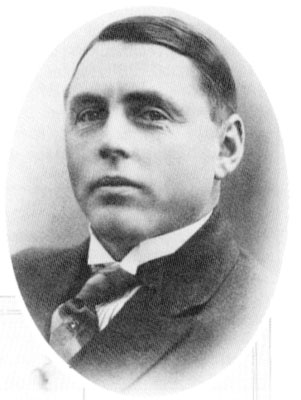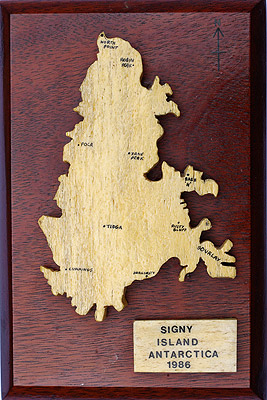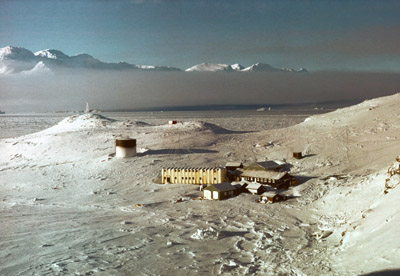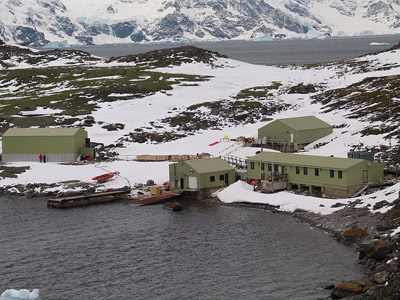Petter Sørlle, 1884-1933
The Naming of Signy Island,
Antarctica
Signy thumbnails pages | Links to all thumbnail pages | 50's -1- -2- -3- 60's -1- -2- -3- -4- -5- -6- -7- 70's -1- -2- -3- 80's -1- -2- 2000's assorted dates -1- -2- Base personnel pictures 50's 60's 70's 80's
 Signy
Island in the South Orkney's group is roughly triangular in
shape, 4 miles long and with a "base" of just under 3 miles
wide, lying to the south of the middle point of Coronation Island.
Unnamed at the time, the appearance of the island was roughly
plotted on James Weddell's chart of 1825.
Signy
Island in the South Orkney's group is roughly triangular in
shape, 4 miles long and with a "base" of just under 3 miles
wide, lying to the south of the middle point of Coronation Island.
Unnamed at the time, the appearance of the island was roughly
plotted on James Weddell's chart of 1825.
The island was given it's name by Capt. Petter Sørlle, of the Norwegian whale-catcher Paal who made a running survey of the island in the 1912-13 season. Captain Sørlle named the island after his wife, Signy Sørlle.
Norwegian biologist Lauritz Sømme worked at the Signy Island scientific station in 1979-80 and on his return to Norway located Signy Sørlle in Oslo. The base personnel of Signy station then sent her a bouquet of flowers each year on her birthday. A representative of British Antarctic Survey, D.D. Wynn-Williams visited Signy in Oslo and a large framed photograph of Signy has hung in the base from shortly after that meeting.
I am very pleased to able to present this information about Petter Sørlle and his family after I unexpectedly received an email from Signy Sørlle's granddaughter Anne Lind from Norway in January 2005.
Petter Sørlle made many whaling trips
in the Antarctic.
He invented the stern slipway
for factory ships in 1925. With this invention whales could
be hauled up into the factory ships at sea, thus allowing
them to operate throughout the open seas of the Southern,
or Antarctic, Ocean without returning to the land station.
But to Petter's advantage, I must add that he also wrote
many letters to newspapers and authorities here in Norway,
warning that there must be made international regulations,
in order to protect the whales from extermination.
He also invented a fire ladder and had lots of other
ideas. He'd wake up in the middle of the night and rush
to the bedroom window and make notes and sketches with charcoal
on the window sill in the moon light/street light (so as
not to wake up my grandmother).
They had five daughters;
Reidun, Marion, Gerd, Margrethe and my mother Signe-Marie.
The season my grandfather mapped and named Signy
Island, he also mapped and named three tiny islands after
his (at the time) three daughters. Reid Island, Mariholm,
and Gerd Island. (Reid and Gerd are located north of Signy
Island, Mariholm to the south. Holm is a Norwegian word
for a very tiny island) He also mapped and named Sørlle
Rocks, west of Coronation Island. (Coronation Island has
a bay to the east called Petter Bay, but I'm not sure if
that was his?)
He missed his girls very much when
out to sea for months and months at a time. And he spoiled
them no end when he was home!
My grandmother's full
name was Signy Therese (maiden name: Gulbraar) Sørlle. Born
May 30, 1892 in Tønsberg. Died Jan 9, 1988 in Oslo. Buried
in Tønsberg.
My grandfather's full name was Petter
Martin Mattias Koch Sørlle. Born Feb 16, 1884, in Thune
near Tønsberg. Died May 29, 1933 in Tønsberg. Buried in
Tønsberg.
They were married in April, 1909 in Oslo.
By the time Signy was twenty, they had three children!
My mother, their youngest (1924), was only 9 when Petter
died. But just like her older sisters, she has very fond
memories of Petter. He was sweet, understanding, inventive
and playful.
Signy and Petter loved each other very
much. She was very sweet and also very beautiful. As I mentioned
before, he missed her very much when he had to go away for
such long stretches at a time. Maybe that's why he named
the very beautiful Signy Island after her?
Unfortunately
I never got to know Petter, since he died so relatively
young. But Signy lived to be almost 96, and I have very,
very fond memories of here. We all called her "Mimi". Mimi
was ever so proud of you people at Signy Island! And very,
very touched that you "boys" remembered her birthday every
year! (And I remember those wonderful bouquets as well)
Anne Lind - Norway, January 2005
 A map of Signy. I tried to find a "normal
map" but couldn't and then spotted the obvious - this map that
I made and hangs over my desk. It is of whalebone cut using
a fine bladed saw in the Antarctic winter in the way that many
of us used to do, spending the time making mementoes and souvenirs
of our time with available materials.
A map of Signy. I tried to find a "normal
map" but couldn't and then spotted the obvious - this map that
I made and hangs over my desk. It is of whalebone cut using
a fine bladed saw in the Antarctic winter in the way that many
of us used to do, spending the time making mementoes and souvenirs
of our time with available materials.Nice pieces of whalebone were at a premium for such work. Whale bone itself was in plentiful supply not too far away as the BAS base was built on the site of a Norwegian whaling station that was built by the Tønsberg Hvalfangeri A/S company in 1920-21 and manned during the summer months only in the late 1920's.
When whales had been flensed of their blubber and other useful products, the carcass was pushed back into the sea to float away and decompose. Many of the carcasses didn't make it very far and there were substantial amounts of whalebone around beaches and coves near to the base.
The date on the map says 1986, but the whale that the bone came from would have probably have died at least 50-60 years earlier.
Places marked from top moving clockwise are:
North Point, Robin Peak, Jane Peak, Base 'H', Rusty Bluff, Gourlay (peninsula), Shagnasty, Cummings, Tioga (central), Foca.


